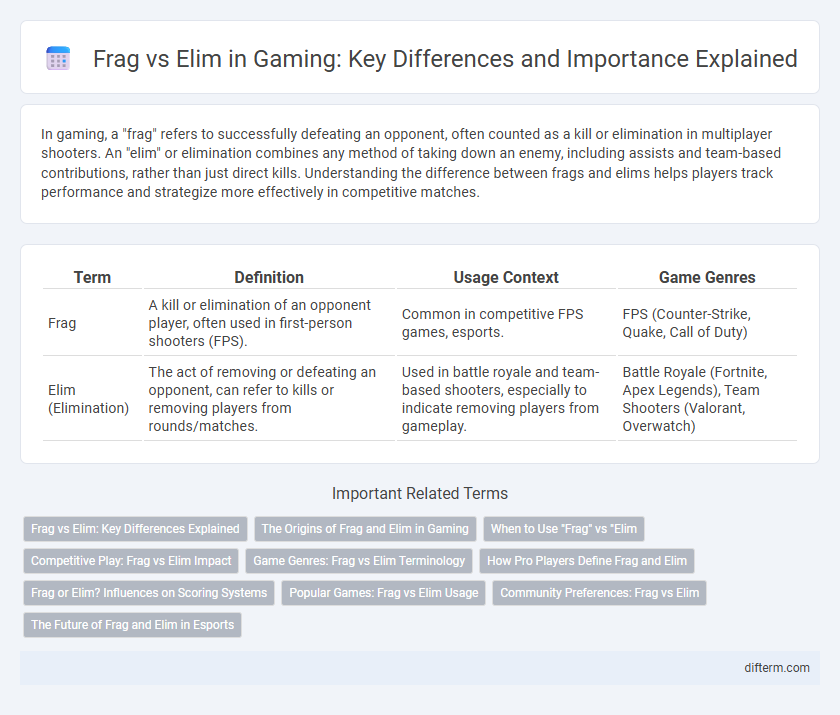In gaming, a "frag" refers to successfully defeating an opponent, often counted as a kill or elimination in multiplayer shooters. An "elim" or elimination combines any method of taking down an enemy, including assists and team-based contributions, rather than just direct kills. Understanding the difference between frags and elims helps players track performance and strategize more effectively in competitive matches.
Table of Comparison
| Term | Definition | Usage Context | Game Genres |
|---|---|---|---|
| Frag | A kill or elimination of an opponent player, often used in first-person shooters (FPS). | Common in competitive FPS games, esports. | FPS (Counter-Strike, Quake, Call of Duty) |
| Elim (Elimination) | The act of removing or defeating an opponent, can refer to kills or removing players from rounds/matches. | Used in battle royale and team-based shooters, especially to indicate removing players from gameplay. | Battle Royale (Fortnite, Apex Legends), Team Shooters (Valorant, Overwatch) |
Frag vs Elim: Key Differences Explained
Frag and elim are core terms in gaming, particularly in first-person shooters, with frag referring to the act of killing an opponent and elim meaning the removal of a player from the game round or match. Frags typically count as individual kills contributing to a player's score, while eliminations often signify a broader game mechanic involving teamwork or objectives. Understanding these distinctions enhances strategic gameplay and player communication in competitive environments.
The Origins of Frag and Elim in Gaming
The terms "frag" and "elim" originate from early multiplayer shooter games where "frag" referred to a kill resulting in the opponent's temporary removal from the game, dating back to titles like Doom and Quake in the 1990s. "Elim," short for elimination, emerged in tactical shooters and battle royales such as Rainbow Six Siege and Fortnite, indicating the removal of an opponent from the round or match. Both terms have evolved to quantify player performance, influencing scoring systems and competitive rankings across diverse gaming genres.
When to Use "Frag" vs "Elim
Use "frag" in fast-paced, tactical shooters like Call of Duty or Counter-Strike to emphasize kills with style or skill, often in multiplayer settings. Opt for "elim" in battle royale or hero shooters like Apex Legends and Overwatch, where it signifies the removal of players or objectives from play, integrating team strategy. Understanding the game's context and community jargon ensures appropriate term usage for clearer communication and enhanced gameplay experience.
Competitive Play: Frag vs Elim Impact
In competitive gaming, the distinction between frags and eliminations significantly impacts player rankings and team strategies. Frags typically count only kills made directly by a player, while eliminations can include assists, rewarding teamwork and strategic plays. Understanding how these metrics influence scoring systems can shape more effective team coordination and optimize performance in tournaments.
Game Genres: Frag vs Elim Terminology
Frag refers to a kill or elimination in fast-paced shooter games like first-person shooters (FPS), emphasizing quick reflexes and precision. Elim, short for elimination, is commonly used in battle royale and team-based shooters, highlighting the strategic removal of opponents from the game. Understanding the distinction between frag and elim helps players adapt their gameplay style across genres such as FPS, battle royale, and tactical shooters.
How Pro Players Define Frag and Elim
Pro players define a frag as a critical kill that directly influences the round's outcome, often emphasizing precision and impact over quantity. Eliminations (elims) encompass any player takedown but lack the strategic weight associated with frags. This distinction highlights how experts prioritize quality kills that shift momentum rather than simply accumulating stats.
Frag or Elim? Influences on Scoring Systems
Frag and elimination (elim) are key metrics in gaming, with frag commonly used in fast-paced shooters to quantify kills, while elim often includes assists and knockdowns, capturing broader player contribution. Scoring systems prioritize frag when emphasizing raw kill count and individual precision, whereas elim-based systems reward strategic teamwork and support play. Understanding the distinction impacts game design, player ranking algorithms, and competitive balance in esports.
Popular Games: Frag vs Elim Usage
In popular games like Call of Duty and Counter-Strike, "frag" is commonly used to denote killing an opponent, emphasizing individual kill counts and player skill. "Elim," short for elimination, often appears in games such as Apex Legends and Valorant, highlighting the removal of an enemy player from the round or match as part of team objectives. Both terms measure combat success but differ in tactical context, with "frag" focusing on kill metrics and "elim" emphasizing strategic team play outcomes.
Community Preferences: Frag vs Elim
In gaming communities, "frag" typically refers to individual kills contributing to a player's score, while "elim" denotes the total eliminations including assists, emphasizing team contributions. Many players prefer frags as they highlight personal skill and precision, while others favor elims for reflecting overall teamwork and strategy effectiveness. Community forums and competitive leaderboards often showcase a balance of these metrics, indicating diverse preferences depending on game genre and playstyle.
The Future of Frag and Elim in Esports
Frag and elim metrics will continue evolving as core performance indicators in esports, driven by data analytics and AI integration. Advanced telemetry tools are enhancing real-time tracking, making frag-to-elim ratios critical for player evaluation and team strategies. Emerging trends suggest a shift towards holistic performance models that combine frag and elim stats with macro gameplay insights for competitive advantage.
frag vs elim Infographic

 difterm.com
difterm.com